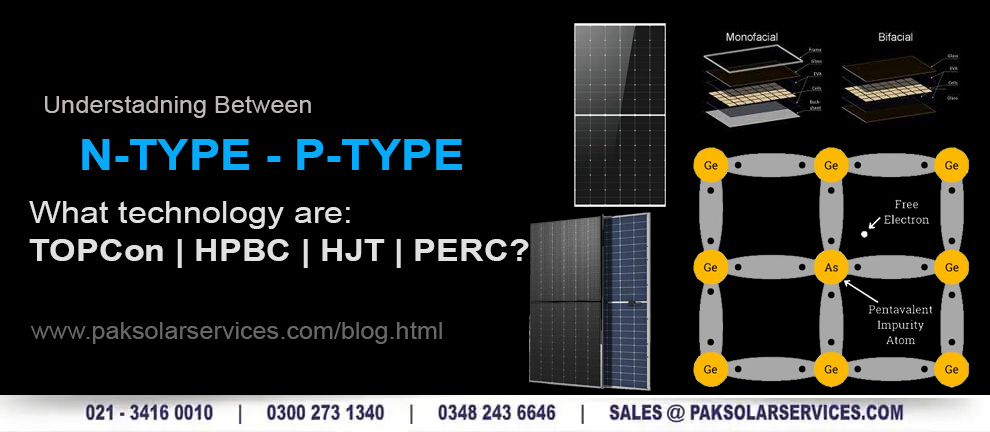What’s the Difference Between TOPCon, HPBC, HJT, PERC, Bi-Facial, and Mono-Facial Panels?
If you’re exploring solar panels, you’ve likely encountered terms like TOPCon, HPBC, HJT, PERC, Bi-Facial, and Mono-Facial. Each one represents an innovation in solar technology, but what sets them apart? Let’s break it all down in easy-to-understand terms!
Understanding N-Type vs. P-Type Solar Cells
Before diving into the technologies, let’s understand the foundation:
P-Type (Positive-Type):
Made with boron-doped silicon, these are widely used in traditional panels (like PERC) but can degrade slightly over time.
N-Type (Negative-Type):
Phosphorus-doped silicon forms the base of N-Type cells, which are more efficient, longer-lasting, and resistant to degradation. Advanced technologies like TOPCon, HJT, and HPBC rely on N-Type cells.
Solar Panel Types: Bi-Facial vs. Mono-Facial
Mono-Facial Panels:These capture sunlight only on the front surface, making them ideal for rooftops or areas where only one side is exposed to sunlight.
Bi-Facial Panels:These can capture sunlight on both the front and rear sides, thanks to their transparent backsheets. They perform exceptionally well in open spaces where sunlight reflects off the ground.
Both Mono-Facial and Bi-Facial designs can incorporate technologies like PERC, TOPCon, HJT, or HPBC, depending on the application.
Breaking Down Solar Panel Technologies
1. PERC (Passivated Emitter Rear Cell)
- Type: Commonly built with P-Type cells, though newer versions may use N-Type.
- Design: Typically Mono-Facial but can be Bi-Facial in some cases.
- What it is: Adds a rear reflective layer to increase sunlight absorption.
- Why it’s great: Affordable and efficient for most needs.
- Best for: Homeowners and businesses seeking cost-effective solutions.
2. TOPCon (Tunnel Oxide Passivated Contact)
- Type: Built with N-Type cells for higher efficiency.
- Design: Available in both Mono-Facial and Bi-Facial options.
- What it is: Adds a tunnel oxide layer for improved energy retention.
- Why it’s great: High efficiency and better performance in low-light conditions.
- Best for: Those needing a balance of cost and performance.
3. HJT (Heterojunction Technology)
- Type: Uses advanced N-Type cells.
- Design: Often used in Bi-Facial panels to maximize efficiency.
- What it is: Combines crystalline silicon with thin-film layers for exceptional performance.
- Why it’s great: High efficiency, excellent temperature tolerance, and superior durability.
- Best for: High-performance projects, especially in extreme climates.
4. HPBC (Hybrid Passivated Back Contact)
- Type: Typically uses N-Type cells.
- Design: Often Mono-Facial but can also be Bi-Facial for premium setups.
- What it is: A back-contact design that eliminates shading on the front surface.
- Why it’s great: Ultra-efficient with a sleek, aesthetic appearance.
- Best for: Premium installations or projects where aesthetics and top-tier performance matter.
Bi-Facial vs. Mono-Facial: Which Should You Choose?
- Mono-Facial Panels:
- Bi-Facial Panels
Final Verdict: What’s the Right Combination for You?
Your ideal combination depends on your project:
- P-Type + PERC:
- Mono-Facial + PERC:
- Bi-Facial + TOPCon:
- Bi-Facial + HJT:
- Mono-Facial + HPBC
Major Solar Panel Manufacturers: A Quick Comparison
Note: Efficiency values are approximate and can vary based on specific models and configurations. For the most accurate and up-to-date information, please refer to the manufacturers' official datasheets or websites. You can find most available brand in Pakistan visit our product page solar panels in Pakistan.
| # | Manufacturer | Models | Technology | Cell Type | Design | Efficiency |
|---|---|---|---|---|---|---|
| 1 | Trina Solar | Vertex Series | HJT | N-Type | Bi-Facial | Up to 25.4% |
| 2 | Longi Solar | Himo7 Series | HPBC | N-Type | Bi-Facial | Up to 23% |
| 3 | Canadian Solar | TB-AG Series | TopCon | N-Type | Bi-Facial | Up to 22.3% |
| 4 | Jinko Solar | Tier pro Series | Perc | N-Type | Bi-Facial | Up to 22.3% |
| 5 | Yingly Solar | Panda Series | HJT | N-Type | Mono Facial | Up to 22% |
Choosing the Right Solar Panel for You
With the rapid evolution of solar technology, you can find panels tailored to your specific needs, whether it’s budget, performance, or aesthetics. Which combination do you think suits your project best? Let us know in the comments!





